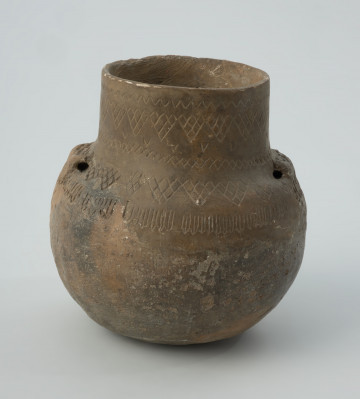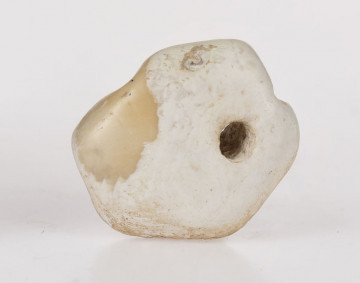
A decorated amphora
3100 p.n.e. — 2600 p.n.e.
National Museum in Szczecin
Part of the collection: Stone Age
The ornamented clay amphora comes from the equipment of a grave discovered in the spring of 1882 during agricultural works near the Liskowo farmstead (German: Grünhof), then belonging to the Rabin estate in the Świdwin district (Gross Rambin). The estate owner, Ludwig Robert Tiede, supervised the opening of the tomb, and the human skeletons and equipment found inside were taken to the manor house, where they were stored together with other archaeological artefacts collected by him in the 1870s and 1880s from the area around Rabin. The tomb, sunk into the ground, was built of boulders. The vertically placed stones adhered to each other, forming the walls of a rectangular chamber with interior dimensions of about 2.5 × 1.25 m and a height of more than a metre. The box was covered with a massive granite boulder laid flat side down. Five skeletons were found inside, three of which were located against the narrow wall and two against adjacent parts of the longer sides of the chamber. The grave gifts were located on the opposite side of the tomb's interior. Among them, there were five clay amphorae of various sizes, two amber ornaments, a flint chisel and a boar's head, the skull of which had been preserved with several vertebrae. The form of the tomb and its equipment allows connecting the find with the people of the Neolithic Globular Amphora culture. Its creation can be dated between the end of the 4th and the first half of the 3rd millennium BC. Soon after Tiede's death, his wife ordered to bury the skeletons from the tomb near the manor house, and in 1891 and 1892, the family donated the relics to the Szczecin Museum collection. All the items from the burial furnishings that have survived to the present day (some earthenware and a flint chisel) are in the National Museum in Szczecin.
Krzysztof Kowalski
Author / creator
Dimensions
cały obiekt: height: 9.8 cm, diameter: 11.2 cm
Object type
ceramic, vessel (container)
Technique
firing, hand made, modelling, manual modelling
Material
clay
Origin / acquisition method
acquisition
Creation time / dating
Creation / finding place
Owner
National Museum in Szczecin
Identification number
Location / status

3100 p.n.e. — 2600 p.n.e.
National Museum in Szczecin

National Museum in Lublin

National Museum in Lublin
DISCOVER this TOPIC
National Museum in Szczecin
DISCOVER this PATH
Educational path